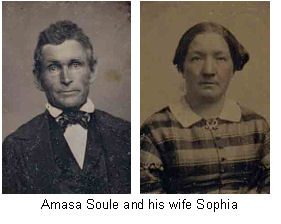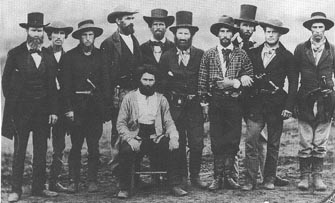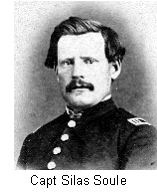

SILAS SOULE AND THE MASSACRE AT SAND CREEK
By Tony Storey
This article was originally published in the December 2009 edition of Soul Search, the journal of The Sole Society
 Silas
Stillman Soule was born on 26 July 1838 in Maine, the second son of Amasa Soule,
a committed abolitionist, and his wife, Sophia.
Silas
Stillman Soule was born on 26 July 1838 in Maine, the second son of Amasa Soule,
a committed abolitionist, and his wife, Sophia.
In 1854 Kansas was still only a territory, sparsely settled but a strong candidate for statehood, As the law allowed the residents of the territory to decide whether it would be a Slave State or a Free State, New England abolitionists formed the Emigrant Aid Society of Boston to help settle the Kansas Territory and bring it into the Union as a Free State. It was Amasa Soule’s strong anti-slavery beliefs that that led to his family moving to the Territory of Kansas in 1854.
Pro-slavery Southerners feared that their congressional power, their economy and their very way of life would be eroded if the Kansas settlers voted for a Free State so began to flood the contested territory with their own settlers. What might have started as a contest to have the majority of settlers and thereby win an election soon escalated into a bloody conflict. These were not merely passive settlers but activists, and both sides were prepared to use deadly force to win the argument.
Amasa Soule made his home at Coal Creek, near Lawrence, Kansas and established his house as a way station on the ‘underground railway’, an escape route for slaves fleeing from the South. Silas, though only a teenager, began escorting runaways from Missouri through Lawrence and north to freedom. Missouri ‘bushwhackers’ were prepared to cross the border to harass the abolitionist settlers and perhaps recapture runaway slaves. The Kansas ‘jayhawkers’ armed themselves with carbines, which were sent west from New England in crates marked ‘Bibles’. Using a so-called ‘Kansas bible’, Silas Soule became an expert at hit-and-run tactics. The era of open warfare between the Missouri slave owners and the Kansas abolitionists became known as ‘Bleeding Kansas’.
 In
January 1859 Dr. John Doy, a Lawrence physician, was escorting a number of
escaped slaves through Kansas when he was captured by a band of Missouri
‘bushwhackers’. Doy was taken across the state border into Missouri where he was
tried and convicted of breaking the Missouri state law by assisting escaped
slaves. Sentenced to five years’ hard labour, Doy was imprisoned in St Joseph,
Missouri. A group of men from Lawrence decided to attempt to rescue Doy and
Silas Soule managed to trick his way into the gaol with a message for Doy to be
ready at midnight. That evening Silas and the others returned and were able to
overpower the guard and take Doy back to Kansas. When the rescue party reached
Lawrence they had a group photograph taken. The photograph of ‘The Immortal Ten’
is now preserved by the Kansas State Historical Society.
In
January 1859 Dr. John Doy, a Lawrence physician, was escorting a number of
escaped slaves through Kansas when he was captured by a band of Missouri
‘bushwhackers’. Doy was taken across the state border into Missouri where he was
tried and convicted of breaking the Missouri state law by assisting escaped
slaves. Sentenced to five years’ hard labour, Doy was imprisoned in St Joseph,
Missouri. A group of men from Lawrence decided to attempt to rescue Doy and
Silas Soule managed to trick his way into the gaol with a message for Doy to be
ready at midnight. That evening Silas and the others returned and were able to
overpower the guard and take Doy back to Kansas. When the rescue party reached
Lawrence they had a group photograph taken. The photograph of ‘The Immortal Ten’
is now preserved by the Kansas State Historical Society.
Later in 1859 Silas Soule was asked to assist in the planned escape of the well-known abolitionist, John Brown, who was being held in Charlestown, Virginia. Brown was facing the death penalty for his attempt in October that year to steal arms for a slave rebellion by an attack on the federal arsenal at Harpers Ferry. Silas succeeded in making contact with the prisoner but Brown refused to escape, believing that his death as a martyr would provoke a war between the north and south, which would better serve his cause. John Brown was hanged in December 1859. His execution was witnessed by an actor, John Wilkes Booth, who would later become infamous as the assassin of President Abraham Lincoln.
In 1860 Silas joined his brother William in Colorado, looking unsuccessfully for gold. When the Civil War began in the spring of 1861 Silas Soule decided to enlist in Company K of the First Colorado Volunteers and did much to encourage his fellow miners to join him. He was commissioned as a First Lieutenant and took part in the Battle of Glorieta Pass in New Mexico in March 1862, helping to prevent the Confederates from capturing the Colorado gold fields. During 1863 Silas continued to serve, fighting Indians and defending the Colorado territory and its citizens.
 By
1864 he was Captain of Company D of the First Colorado Cavalry, based at Fort
Lyon, under the command of Major Ned Wyncoop. In September 1864 he and Wyncoop
brought Chief Black Kettle and a peace delegation to Denver City to meet the
Territorial Governor John Evans and the Commander of the Military District,
Colonel John Chivington, in what became known as the Camp Weld Council. A group
photograph of the delegates including Soule and Wyncoop survives but the
initiative was doomed to fail. Evans and Chivington, a former Methodist preacher
with political ambitions, had little interest in peace treaties and their only
response was to relieve Major Wyncoop of his command.
By
1864 he was Captain of Company D of the First Colorado Cavalry, based at Fort
Lyon, under the command of Major Ned Wyncoop. In September 1864 he and Wyncoop
brought Chief Black Kettle and a peace delegation to Denver City to meet the
Territorial Governor John Evans and the Commander of the Military District,
Colonel John Chivington, in what became known as the Camp Weld Council. A group
photograph of the delegates including Soule and Wyncoop survives but the
initiative was doomed to fail. Evans and Chivington, a former Methodist preacher
with political ambitions, had little interest in peace treaties and their only
response was to relieve Major Wyncoop of his command.
Chief Black Kettle was the peaceful leader of a band of about 600 Cheyenne and Arapahos that hunted the buffalo along the Arkansas River. In late November 1864 the Indians reported to Fort Lyon and made their camp on Sand Creek, believing themselves to be under the protection of the U.S. Army. A year earlier, Black Kettle had visited Washington, where the Commissioner of Indian Affairs had presented him with a 34 star flag, saying that soldiers would never fire on him as long as he flew the Stars and Stripes. The chief flew the flag above his tipi, together with a white flag as a further sign of peace.
On 28 November 1864, Colonel Chivington moved his troops, including Company D of the First Colorado Cavalry under Captain Silas Soule, to within a few miles of Chief Black Kettle’s encampment. The Indians were mainly old men, women and children as most of the young men were away hunting for food. That evening Chivington declared his intention to slaughter the innocent and virtually defenceless inhabitants without warning. Silas Soule remonstrated with his commanding officer and extracted a promise that there would be no attack on the camp after all.
Early the following morning Colonel John Chivington went back on his word and ordered the cavalry to attack. Captain Soule ordered his own men to stay put and hold their fire, but Chivington’s troops went ahead with the charge and the resulting action was initially known as the Battle of Sand Creek. At least 160 members of the Cheyenne and Arapaho tribes were hunted down and killed. About two thirds of the casualties were women and children, against whom Chivington’s men committed atrocities of various descriptions, before taking their scalps.
The public were not immediately aware of the details of the events at Sand Creek and Colonel Chivington was feted as a hero. Following a parade through the streets of Denver he appeared on a stage displaying a number of grisly trophies including a hundred scalps. Silas Soule wrote to a friend that it was “…hard for me to see little children on their knees begging for their lives, to have their brains beaten out like dogs.” Other witnesses to the slaughter spoke out and the authorities had little choice but to investigate Chivington’s conduct.
A Military Commission was appointed to take the testimony of soldiers and officers involved in the Sand Creek affair and present its findings to the War Department. When the army convened the committee of inquiry in Denver, factions loyal to Chivington threatened any hostile witnesses and the hearings were held in an atmospere of fear and intimidation. Despite threats against him, Silas Soule gave his account to the Commission. In turn John Chivington was allowed to cross-examine witnesses and present rebuttal witnesses. The Commission retired to consider its findings.
Meanwhile, Silas Soule’s enlistment with his regiment expired and he joined the Colorado Veteran’s Service and was assigned to the Denver Provost Guard as Provost Marshall. On 1 April 1865 Silas Soule married Hersa Coberly, the daughter of James Coberly, a Colorado pioneer who had been killed by Indians in the summer of 1864. Soule had previously confided to a friend that testifying to the Commission could cost him his life and barely three weeks after his wedding, on the evening of 23 April 1865, Silas Soule was gunned down on Lawrence Street, Denver, Colorado.
Soule’s killer, Private Charles Squires of the Colorado Second Regiment, fled to New Mexico, where he was apprehended and brought back to Denver to face a charge of murder. However Squires was allowed to escape, this time to California, and was never brought to trial. Silas Soule had survived previous attempts on his life and the suggestion that Chivington may have been complicit in Soule’s murder, although widely believed, was never proven.
The Commission finally published its findings and concluded that the raid at Sand Creek was ‘a cowardly, cold-blooded slaughter, sufficient to cover its perpetrators with indelible infamy, and the face of every American with shame and indignation’. What had been the Battle of Sand Creek was renamed the Sand Creek Massacre. The War Department issued a written condemnation of Colonel Chivington’s actions but, because he was no longer in the service of the military, John Chivington could not be tried by a military court.
Some elements in the military had been planning to wage a war of extermination against the Plains Indians but when the Army asked for thousands of extra troops, the United States Congress refused the request, very probably influenced by the public outrage at the Sand Creek Massacre.
Silas Soule’s actions on the morning of 29 November 1864 enabled many innocent Native Americans to escape the slaughter that day. Although Silas Soule did not live to hear the Commission’s conclusions, it seems his testimony, for which he may have paid with his life, helped to save the lives of many more Native Americans in the years that followed. n
Acknowledgements:
- Bruce M Lawlor, author of Silas Soule, Massachusetts Abolitionist published in America’s Civil War magazine
- C A Prentice, author of Captain Silas S Soule, a Pioneer Martyr published in The Colorado Magazine, 1927
- Byron Strom
- Wikipedia